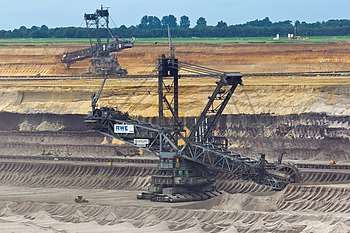Bagger 288
Bagger 288 (Excavator 288), built by the German company Krupp for the energy and mining firm Rheinbraun, is a bucket-wheel excavator or mobile strip mining machine.
| Bagger 288 | |
|---|---|
 | |
| Type | Bucket-wheel Excavator |
| Manufacturer | ThyssenKrupp |
| Production | 1978 |
| Length | 220 m (721 ft) |
| Width | 46 m (151 ft) |
| Height | 96 m (315 ft) |
| Weight | 13,500 t (29,800,000 lb) |
| Propulsion | 12 x caterpillar tracks |
| Gross power | 16.56 megawatts of externally supplied electricity |
| Speed | 2 to 10 m (6.6 to 32.8 ft) per minute (0.1 to 0.6 km/h) |
| Blade capacity | 21 m (70.1 ft) in diameter, 18 buckets each holding 8.6 cubic yards (6.6 m3) or 7.2 short tons (6.5 t) |
When its construction was completed in 1978, Bagger 288 superseded Big Muskie as the heaviest land vehicle in the world, at 13,500 tons.[1] It took five years to design and manufacture, and five years to assemble with total cost reaching $100 million.[2] In 1995, it was itself superseded by the slightly heavier Bagger 293 (14,200 tons). NASA's Crawler-Transporter still remains the largest self-propelled land vehicle in the world, since bucket-wheel excavators are powered by an external power source, and the Overburden Conveyor Bridge F60s hold the title of largest land vehicle of any type by physical dimensions.
Objective

The Bagger 288 was built for the job of removing overburden before coal mining at the Hambach stripmine in Germany. It can excavate 240,000 tons of coal[3] or 240,000 cubic metres of overburden daily[4] – the equivalent of a football field dug to 30 m (98 ft) deep. The coal produced in one day fills 2400 coal wagons. The excavator is up to 220 m (721 ft) long (slightly shorter than Baggers 287 and 293) and approximately 96 m (315 ft) high. The Bagger's operation requires 16.56 megawatts of externally supplied electricity.[5] It can travel 2 to 10 m (6.6 to 32.8 ft) per minute (0.1 to 0.6 km/h). The chassis of the main section is 46 m (151 ft) wide and sits on 3 rows of 4 caterpillar track assemblies, each 3.8 m (12 ft) wide. The large surface area of the tracks means the ground pressure of the Bagger 288 is very small (1.71 bar or 24.8 psi); this allows the excavator to travel over gravel, earth and even grass without leaving a significant track. It has a minimum turning radius of approximately 50 metres, and can climb a maximum gradient of 1:18 (5° incline).
The excavating head itself is 21.6 m (70 ft 10 in) in diameter and has 18 buckets each holding 6.6 cubic metres (8.6 cu yd) of overburden.
By February 2001, the excavator had completely exposed the coal source at the Tagebau Hambach mine and was no longer needed there. In three weeks it made a 22-kilometre (14 mi) trip to the Tagebau Garzweiler, traveling across Autobahn 61, the river Erft, a railroad line, and several roads. The move cost nearly 15 million German marks and required a team of seventy workers. Rivers were crossed by placing large steel pipes for the water to flow through and providing a smooth surface over the pipes with rocks and gravel. Special grass was seeded to smooth its passage over valuable terrain. Moving Bagger 288 in one piece was more economical than disassembling the excavator and moving it piece by piece.
The Bagger 288 is one of a group of similar sized and built vehicles, such as Bagger 281 (built in 1958), Bagger 285 (1975), Bagger 287 (1976), Bagger 293 (1995), etc.[5]

In popular culture
- In the film Ghost Rider: Spirit of Vengeance (2012), the rider possesses a Bagger 288 turning it into a fiery vehicle of destruction against his enemies.[6]
- In the popular videogame Rust (2013), there is a large monument with the title "Giant Excavator Pit". The developers of the game told in a press release that the location was modeled after the Bagger 288.
Notes
- 13,500 tons
- Malone, Robert (12 March 2007). "The World's Biggest Land Vehicle". Forbes. Retrieved 5 January 2017.
- Giampietro, Mario; Kōzō Mayumi (31 October 2009). The Biofuel Delusion: The Fallacy of Large-Scale Agro-Biofuel Production. Earthscan. p. 134. ISBN 978-1-84407-681-9. Retrieved 10 April 2012.
- "Bagger 288 – a giant among bucket wheel excavators". thyssenkrupp Industrial Solutions product information page. thyssenkrupp Industrial Solutions AG. 2018. Archived from the original on 2019-01-27. Retrieved 27 January 2019.
- Die grössten Bagger der Welt (The biggest excavators in the world) (in German)
- "'Chatting with Ghost Rider: Spirit of Vengeance directors Neveldine and Taylor'". DigitalTrends.com. Retrieved December 16, 2013.
External links
- Additional pictures 1 and 2
- Bagger 288 crossing the river Erft during the 2001 move (pictures)
- Manufacturer's homepage